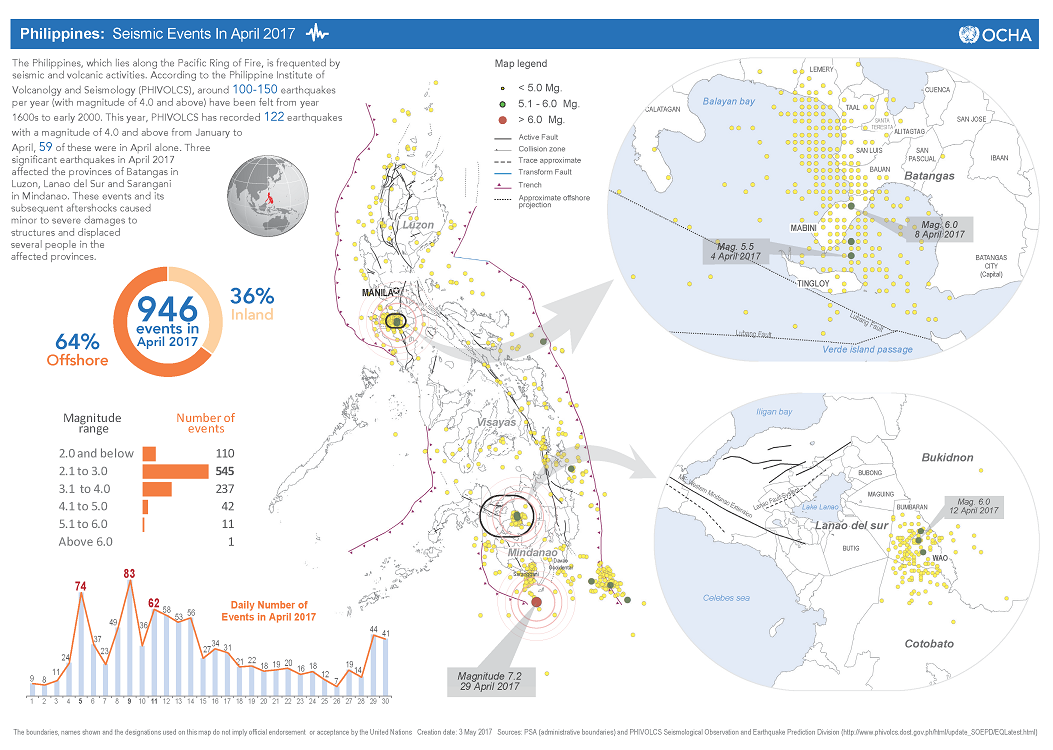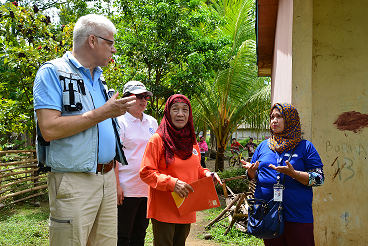
Seeking sustainable peace in Basilan and Sulu
The Autonomous Region in Muslim Mindanao (ARMM), located in the Southern part of the Philippines is composed of the five provinces of Basilan, Lanao del Sur, Maguindanao, Sulu, and Tawi-tawi. The ARMM region remains the poorest in the country with the highest poverty incidence of 53.4% recorded in 2015 according to the Philippine Statistics Authority’s Family Income and Expenditure Survey. Protracted conflict over the years has become a major obstacle to sustainable peace and development, leaving families struggling to meet basic necessities and continue their livelihood.
The presence of non-state armed groups reportedly involved in kidnap-for-ransom activities of foreign and local nationals remain a big challenge to the community and Government. In April 2016, the Philippine military stepped up its law enforcement operations against the Abu Sayyaf Group (ASG) in Basilan in Al-Barka and Tipo-Tipo municipalities. The encounter resulted in the displacement of more than 3,400 people. In Sulu, encounters in the municipalities of Talipao and Maimbung displaced 1,666 people as well as affecting the municipalities of Patikul and Indanan which has seen heavy fighting. Following the proclamation of the President to eradicate the group, sustained military operations are affecting the local population. However, by December of 2016, most of the displaced have returned to their homes. From January 2016 to February 2017, over 68,400 people were displaced in Sulu and Basilan due to conflict.
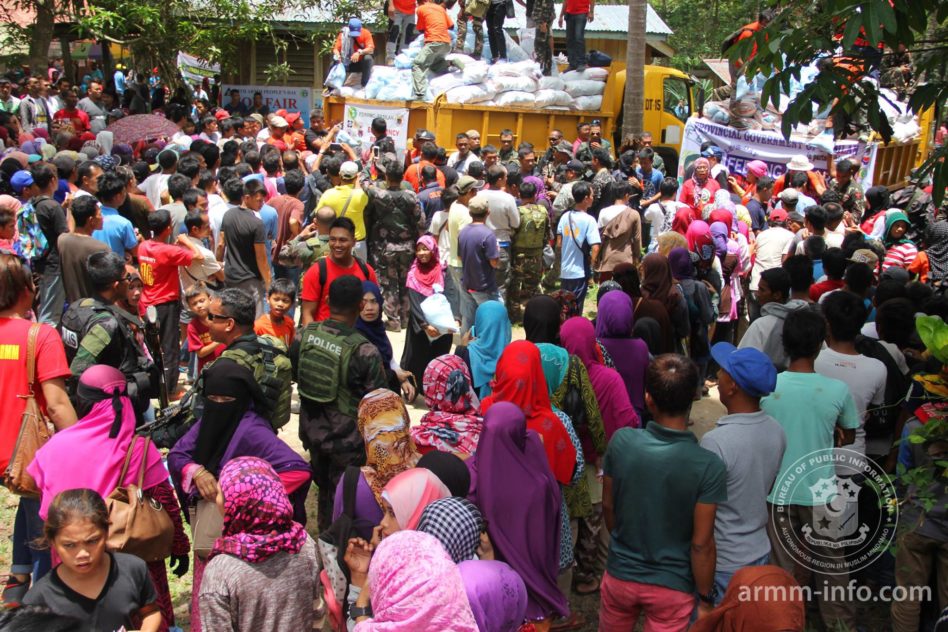
Credit: ARMM Bureau of Public Information Al Barka, Basilan (27 March 2017) - The ARMM government together with Basilan local authorities deliver relief items, agricultural seedlings, children's books and other humanitarian assistance during a monthly event called People's Day.
Renewed conflict and displacement in 2017
In 2017, renewed military operations against the ASG continues. On 27 February, more than 1,500 families from the seven barangays in Al-Barka municipality were displaced. Residents from the barangays of Macalang, Danapah, Linuan, Guinanta, Magcawa and Cailih fled for fear of being caught in the cross fire. Early in March, another firefight was reported in Barangay Cambug, Al-Barka, resulting in the displacement of 8,970 people; and about 600 families were again displaced because of encounter in Sitio Lingasug, Barangay Mangalut, Al-Barka. According to the Protection Cluster's Mindanao Displacement Dashboard, in Sulu, 1,485 people were displaced from the municipality of Indanan. On 6 March about 4,320 people were displaced from Indanan, Patikul, Parang. Protection monitors on the ground indicated that mortar shelling carried out by the Philippine army triggered fear among civilians, causing them to flee.
The number of agencies that are able to reach some of the population are limited due to access and security issues. Multiple and protracted conflict in Sulu and Basilan are taking a heavy toll on the local population. Assistance from humanitarian actors has been limited for fear of being kidnapped. However, the ARMM Regional Government through its Humanitarian Emergency Action and Response Team (ARMM-HEART), the Department of Social Welfare and Development and the Office of Civil Defense at the provincial and municipal levels continue to provide food and relief items. Due to the continuous conflict in the region, the assistance is often not enough to provide the overall well-being of the affected population. Family food packs of five kilos of rice, sardines, instant noodles and coffee are distributed during the onset of the displacement. Families are often left searching for food and other needs during prolonged displacement. As a mitigation measure, families take the risk of returning immediately to their homes as soon as the guns fall silent.
Recovery of livelihood is a major challenge for the return population says the director of Integrated Resource Development for Tri-People, a local NGO. Transportation of relief items is also difficult in the island provinces. Until longer-term interventions can be put forward and implemented in the ARMM, communities from the Mindanao island provinces will continue to suffer frequent displacement, disruption of their daily life and high levels of poverty.
As a mitigation measure, families take the risk of returning immediately to their homes as soon as the guns fall silent.
Humanitarian Coordinator's visit to Mindanao
The Humanitarian Coordinator in the Philippines, Mr. Ola Almgren visited Cotabato City and Maguindanao on 5-7 April 2017 to meet local authorities and partners and to be apprised of the humanitarian situation and challenges in Mindanao.
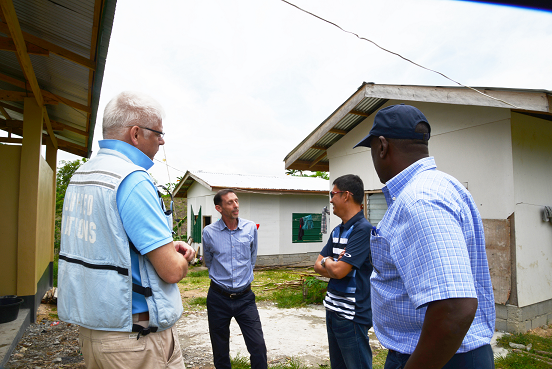
Briefing with the Mindanao Humanitarian Team
In a meeting with the Mindanao Humanitarian Team (MHT) in Cotabato City, Mr. Almgren highlighted the coordination of humanitarian and development workers in responding to the acute and protracted needs of affected people in Mindanao. Over 30 members of the MHT, representing UN agencies and non-governmental organizations met with Mr. Almgren. He commended the work done by non-governmental organizations, UN agencies and other partners on ground, who ensure that the most vulnerable populations are reached with their respective programmes.
UNHCR Quick Impact Project in Maguindanao
The Humanitarian Coordinator also visited a hillside community in Barangay Kabengi, municipality of Datu Saudi Ampatuan. Around 150 families relocated to this village where the Government built 120 houses for the displaced families. These families were displaced from an armed conflict in 2015 between the Armed Forces of the Philippines (AFP) and the Bangsamoro Islamic Freedom Fighters (BIFF) within the Salibu, Pagatin, Mamasapano and Shariff Aguak areas.
Fearing a renewed armed encounter, returns to their villages have been limited. Some have opted to resettle in the area. The municipal administrator informed the Humanitarian Coordinator that the site is a peaceful area in Datu Saudi Ampatuan, and considered as a ‘zone of peace’. The United National High Commissioner for Refugees (UNHCR) through Community and Family Services International (CFSI), implemented a potable water system for the village, which was an identified priority need of the community. Government projects such as a marketplace, barangay hall, public restrooms and a health center were also built for the community.
The municipal administrator, Mr. Mastura Mustapha informed the Humanitarian Coordinator that initially there were only around 50 families staying at the site. But the water project has attracted people who used to walk 1.5 kilometres to collect water, and more IDPs have settled in to the area.
The Humanitarian Coordinator noted that despite the scarcity of resources, agencies on the ground were able to implement projects that made a difference to the lives of the affected communities. He stressed the importance of coordinating between humanitarian and devlopment actors, and engaging with local authorities and partners to ensure sustainability of efforts.
Educational support to conflictaffected children in Mindanao
On 6 April, the Humanitarian Coordinator visited Katibpuan Elementary School in the municipality of Talayan, where the International Organization for Migration (IOM) supported an 18-month project to increase the school children’s access to education. Mr. Almgren was met by the school principal Mrs. Bayang Panalangin. She has been teaching in the school for almost 30 years. Before the project, several classrooms had no ceilings. The roof was made of metal sheeting, making it too hot for the pupils and teachers.
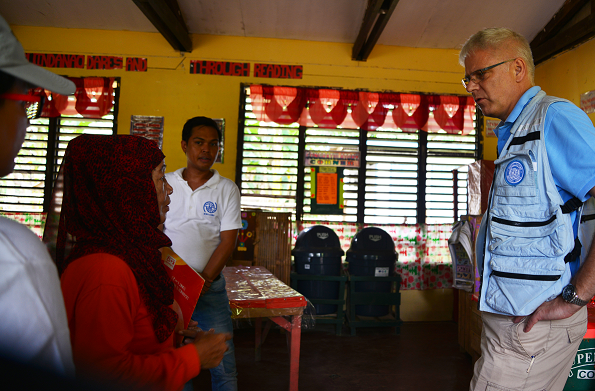
Repairs had not been made to the school since the early 80's and was badly in need of refurbishing. More than 340 students from Katibpuan Elementary School benefitted from the project through classroom repairs, construction of WASH facilities and provision of school supplies, and a school vegetable farm. The project improved not only the access but also the protection and resilience of children in conflict-affected areas. The school hosted IDPs for one month last year during an armed conflict which caused villagers to flee. “Our school became a half way home; a school at daytime but hosting the IDPs at nighttime”, says Mrs. Panalangin.
IOM implemented the project in partnership with a local organization the Assistance and Cooperation for Community Resilience and Development (ACCORD), and was funded by the European Civil Protection and Humanitarian Aid Operations (ECHO). From north
The project improved not only the access but also the protection and resilience of children in conflict-affected areas.
From north to south, earthquakes jolt the Philippines in April
A series of earthquakes both in the northern and southern regions jolted the Philippines in April, causing citizens to evacuate their homes and public buildings. Over 940 earthquake events were recorded in more than 40 provinces in April alone. More than 50 had a magnitude greater than 4.0. National and regional social welfare authorities are augmenting relief efforts, including the provision of psycho-social services, to the affected communities. The National Disaster Risk Reduction Management Council (NDRRMC) is currently rolling out the recently updated National Disaster Response Plan (NDRP) at the regional level. The NDRP covers multiple hazards: hydro-meteorological, earthquake and tsunami, and terrorism. It is intended to serve as a guide for local hazard response plans. The NDRRMC conducts quarterly earthquake drills to test the NDRP's effectiveness.
5 and 8 April: Mabini and Tingloy, Batangas
Two earthquakes with a 5.5 and 6.0-magnitude struck near the towns of Tingloy and Mabini, Batangas province, on 5 and 8 April, respectively. As of 19 April, 3,578 people are displaced and 3,114 houses are damaged, about 80 per cent of which are located in Mabini and Tingloy. Several public buildings, hospitals, schools and places of worship also incurred minor damages.
12 April: Wao, Lanao del Sur
As of 20 April, over 5,000 people in the town of Wao, Lanao del Sur province, in the Autonomous Region in Muslim Mindanao, are affected by the 6.0-magnitude earthquakes that struck on 12 April and subsequent aftershocks. All are staying outside their homes out of fear of aftershocks. Over 400 aftershocks have been recorded, with six exceeding 5.0 in magnitude. No casualties have been reported. To date, 869 houses have been damaged or destroyed. Several govTernment buildings, schools and places of worship in the area have also received minor damages. Both Wao and the neighbouring town of Kalilangan, Bukidnon province, have declared states of calamity, allowing the release of disaster funds.
29 April: Sarangani, Davao Occidental
An 7.2-magnitude earthquake was recorded off the coast in Sarangani, Davao Occidental. The strong tremor was felt across major cities in Mindanao. Authorities issued a tsunami alert following the quake that was shortly lifted. As of 1 May, 442 aftershocks were reported. Three families were displaced and sought shelter at a barangay captain’s house in the village of Tango in Glan, Sarangani. No major damage or fatalities were reported.
Both Wao and the neighboring town of Kalilangan, Bukidnon province have declared states of calamity, allowing the release of disaster funds.
